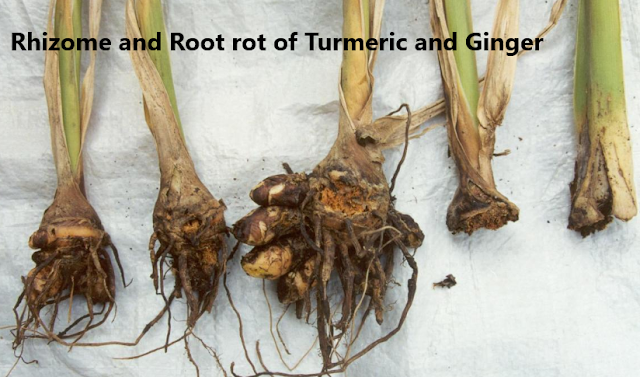Symptoms and management of Rhizome rot of Turmeric and Ginger
Causal organisms: Pythium graminicolum and P. aphaniderrnatum.
The disease is soilborne and rhizomes borne and occurs with the onset of monsoon.
Symptoms of Rhizome rot of Turmeric and Ginger
Above ground
1. The infection starts at the collar region of the pseudostem and progresses upwards as well as downwards. 2. The collar region of the affected pseudostem becomes water soaked and the rotting spreads to the rhizome resulting in soft rot. 3. Foliar symptoms appear as light yellowing of the tips of lower leaves which gradually spreads to the leaf blades. 4. In early stages of the disease, the middle portion of the leaves remain green while the margins become yellow. 5. Later, the yellowing spreads to all leaves of the plant from the lower region upwards and is followed by drooping, withering and drying of pseudostems.
Below Ground
1. At a later stage, fungal infection decays the rhizome as well as roots.
2. Poorly developed roots and less formation of the rhizome are the other symptoms.
Favourable conditions of Rhizome rot of Turmeric and Ginger
▲ Younger sprouts are the most susceptible to the pathogen. Nematode infestation aggravates rhizome rot disease. ▲ Temperature above 30°C and high soil moisture are the important predisposing factors favouring the disease.
▲ Water logging in the field due to poor drainage increases the intensity of the disease.
Control Measures/Management of Rhizome rot of Turmeric and Ginger
♦ Seed material should be selected from disease free areas. ♦ Avoid water stagnation in the field. Light soil may be preferred and drainage facility to be ensured.
♦ Grow tolerant varieties.
♦ Crop rotation to be followed. ♦ Deep plough in summer. Planting is to be done in ridge and furrow method. ♦ Remove diseased plants and the soil around plants to be drenced with Mancozeb (3 gm/lit) or 3 gm Ridomil M.Z. ♦ At the time of sowing, treat the rhizome with Bordeaux mixture (1%) and again with Trichoderma @ 810gm/litre water.
♦ Spray the crop with Mancozeb (2.5 g/lit) or Carbendazim (1 g/lit) +1 ml sandovit. ♦ Keep rhizomes in 3g Metalaxyl or 3g Mancozeb mixed in one litre of water for one hour and shade dry before planting.
